#princess Maria Gabriella of savoy
Explore tagged Tumblr posts
Text


The arrival of Princess Grace and Prince Rainier at the wedding of Princess Maria Gabriella of Savoy and Robert de Balkany at Balsan Castle in Eze (France) on June 21, 1969.
#grace kelly#princess grace#floral#hat#cartier#maria gabriella of savoy#savoy#maria gabriella#robert de balkany#balsan castle#eze#france#1969#june 21
9 notes
·
View notes
Text

Maria Luisa of Savoy
Artist: Louis-Michel van Loo (French, 1707–1771)
Title: Princess Maria Luisa of Savoy (1729–1767), daughter of Charles Emmanuel III of Sardinia.
Date: 1733
Medium: Oil on Canvas
Collection: Accorsi-Ometto Museum, Turin, Italy
DESCRIPTION
Maria Luisa Gabriella of Savoy (25 March 1729 – 22 June 1767) was a princess of Savoy.
Maria Luisa was the second daughter born to the reigning King of Sardinia and his second wife, the German Princess Polyxena of Hessen-Rheinfels-Rotenburg who died in 1735, Marie Luisa being just five years of age. She was named after her aunt, Maria Luisa Gabriella of Savoy (1688–1714) who was Queen of Spain as wife of Philip V of Spain.
#portrait#princess#maria luisa of savoy#house of savoy#italian royal family#italian royalty#18th century painting#oil on canvas#louis michel van loo#french painter#european art#french culture#little girl#costume#landscape#flowers
2 notes
·
View notes
Photo

THE FAMILY
T.M. King Umberto II and Queen Maria Jose of Italy with T.R.H. Princess Beatrice, Princess Maria Gabriella and Princess Maria Pia of Savoy; and Prince Vittorio Emanuele of Naples
#the family#king umberto ii of italy#queen maria jose of italy#princess maria gabriella of savoy#princess beatrice of savoy#princess maria pia of savoy#prince vittorio emanuele of savoy#savoy#italia#italy#savoia#royal#royals#royalty#royaltyedit
21 notes
·
View notes
Photo

Princess Maria Gabriella of Savoy’s Pearl Tiara
Find out more at Tiara Mania
#Princess Maria Gabriella#Italian Royal Family#Italy#tiara#Savoy#pearl#Petochi#tiaras#diadem#diadems#royal tiaras#jewels#royal jewels#royal#royals#royalty#jewellery#jewelry#crown#crowns#crown jewels
215 notes
·
View notes
Photo
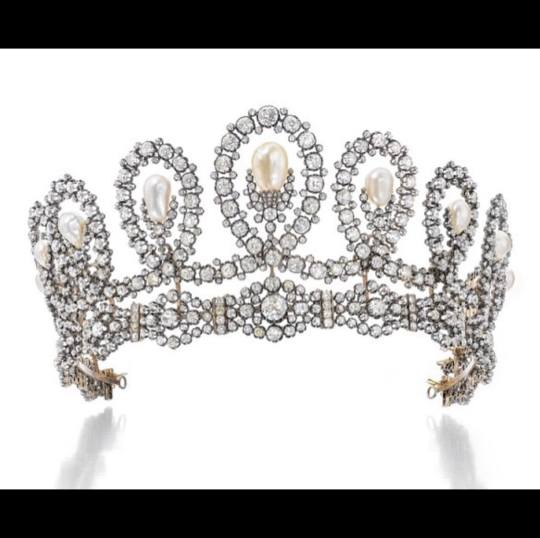
Queen Maria Vittoria of Spain's Diamond and Pearl Tiara.
~ This tiara is composed of graduated volute motifs set with cushion-cut, circular and single diamonds, framing 11 natural pear-shaped pearls, whose central pearl is supported by a pink diamond setting, all resting on a base. detachable consisting of diamond-set cluster motifs, and in addition the top of the tiara can also be worn separately as a necklace.Made for Princess Maria Vittoria dal Pozzo della Cisterna, daughter of Prince Carlo Emanuele dal Pozzo della Cisterna and Countess Louise of Merode, this jewel was purchased by Maria Vittoria shortly after her wedding in 1867 with Prince Amedeo of Savoy, I Duke of Aosta and later King Amedeo I of Spain.Unfortunately, Maria Vittoria died of tuberculosis in 1876 at the age of 29 and the tiara disappeared from circulation, so much so that there were many hypotheses about the fate of the piece, some in fact claimed that it had been inherited from the second-born son, Prince Vittorio Emanuele of Savoy-Aosta. , The Counts of Turin, others thought it had been inherited by the youngest son, Prince Luigi Amedeo of Savoy-Aosta, I Duca degli Abruzzi.What exactly happened to the tiara remains unclear, but it is known that, since Vittorio Emanuele and Luigi Amedeo died without descendants, King Umberto II of Italy bought it so that the tiara would not abandon the family collection. Later this jewel was donated to Princess Maria Gabriella of Savoy, who, however, in 2021 put it up for auction at Sotheby's, who after having estimated it between $ 1,000,000 and $ 1,500,000, selling it for approximately $ 1,600,000 to an unknown buyer. ~
4 notes
·
View notes
Photo

Maria Anna Carolina Gabriella of Savoy (17 December 1757 – 11 October 1824) was a Princess of Savoy by birth and Duchess of Chablais by her marriage to her uncle, Prince Benedetto, Duke of Chablais.
3 notes
·
View notes
Photo








Elisabeth Alexandra Gabriella Annunciata Charlotte Teresa
As the daughter of a Habsburg, Elisabeth was given the name Teresa. The most famous of which was Empress Maria Theresa, the last of the House of Habsburg and the real power of the Holy Roman Empire under her husband Francis I.
The given name of Maria Theresa had been in the Habsburg family since the 17th century. Maria Theresa of Spain was the wife of King Louis XIV and through him, gave their grandson a claim to the Spanish throne bringing the Bourbons to Spain. Since then, almost every Maria Theresa has left their mark in history.
Empress Maria Theresa’s granddaughter Maria Theresa of Naples and Sicily married her double first cousin giving birth to almost a dozen children. Her children were an Emperor of Austria, Empress of the French, Empress of Brazil & Queen of Portugal and a Crown Princess of Saxony.
Mother and daughter, Maria Theresa of Austria-Este and Maria Theresa of Savoy married Italian Bourbons. The mother was Queen of Sardinia and the other was Duchess of Parma. It is through Felix, Prince Consort of Luxembourg and Empress Zita of Austria that Maria’s Theresa descendants are still in reigning monarchies.
Another Maria Theresa of Savoy was the grandmother of the last Duchess of Parma, Louise Marie Therese. Her husband, Louis XIX of France became king over two decades after her death meaning Maria Theresa never got the title Queen of France.
The most recent Maria Theresa to become Queen was Maria Theresa of Austria, Queen of the Two Sicilies. Like Habsburgs and Bourbons before her, Maria Theresa married her children into the Bourbon-Parma family and Austria Imperial Family.
Maria Theresa, Grand Duchess of Luxembourg was the first of the Americas. As a Cuban, Maria Theresa was the beginning of marriages to commoners in European royalty. As a great-aunt of Lady Elisabeth, Maria Theresa greatly influenced Elisabeth’s life and that of her sister, Alice. The two girls eventually converted to Catholicism.
10 notes
·
View notes
Photo

Gaspar Peeter Verbruggen (II) - Portrait of Maria Luisa of Savoy in the Frame Decorated with Flowers - 1704
Maria Luisa of Savoy (Maria Luisa Gabriella; 17 September 1688 – 14 February 1714) was a queen consort of Spain by marriage to Philip V of Spain. She acted as Regent of Spain during the absence of her spouse from 1702 until 1703, and had great influence over him as his adviser, while she was herself in turn influenced by the Princesse des Ursins.
Gaspar Peeter Verbruggen or Gasparo Pedro Verbruggen (baptized on 11 April 1664 in Antwerp – buried on 14 March 1730 in Antwerp) was a Flemish still life painter who is principally known for his decorative still lifes with flowers and fruit. He collaborated with figure artists on compositions which combined figures with a still life element. He was active in Antwerp and The Hague.
15 notes
·
View notes
Photo










Royal Birthdays for today, February 24th:
Toba, Emperor of Japan, 1103
Louis, Duke of Savoy, 1413
Charles V, Holy Roman Emperor, 1500
Matthias, Holy Roman Emperor, 1557
Charles Alexander, Margrave of Brandenburg-Ansbach, 1736
Rama II, King of Siam, 1767
Prince Adolphus, Duke of Cambridge, 1774
Maria Gabriella, Princess of Savoy, 1940
Prince Carlo, Duke of Castro, 1963
Arrietta Morales y de Grecia, Granddaughter of Constantine II, 2002
#rama ii#prince adolphus#maria gabriella of savoy#prince carlo#charles v#emperor toba#emperor matthias#charles alexander of Brandenburg-Ansbach#louis of savoy#Arrietta Morales y de Grecia#royal birthdays#long live the queue
51 notes
·
View notes
Text





The wedding of King Constantine II of the Hellenes, and Princess Anne-Marie of Denmark took place on Friday, 18 September 1964 at the Metropolitan Cathedral of Athens, two weeks after Anne-Marie's 18th birthday.Constantine II, King of the Hellenes was the only son of King Paul of the Hellenes and Princess Friederike of Hanover, while Princess Anne-Marie was the youngest daughter of King Frederick IX of Denmark and Princess Ingrid of Sweden. It was the first, and to date only, wedding of a Greek monarch whilst they sat on the throne to be held in Greece
Princess Anne-Marie wore a relatively unadorned gown by Danish designer, Jørgen Bender. Her Irish lace veil, worn by her maternal grandmother, Princess Margaret of Connaught at her own wedding in 1905, was anchored by a Cartier diamond tiara given to Princess Margaret by the Khedive of Egypt. The veil had also been worn by her mother, Queen Ingrid, in 1935. The veil and tiara together have been worn by all of Ingrid's female descendants.
King Constantine II wore the ceremonial uniform of field marshal of the Hellenic Army. He wore the riband and star of the Order of the Redeemer as well as all his other medals and decorations.
The wedding was attended by 1200 guests from all over the world. As both the bride and groom were descendants of Victoria of the United Kingdom and Christian IX of Denmark, they were closely related to almost all of the royal houses in Europe, many of whom were in attendance.
The Royal Guests
House of Glücksburg
The King and Queen of Denmark, the bride's parents
Princess Margrethe of Denmark, the bride's sister
Princess Benedikte of Denmark, the bride's sister
Prince Ingolf of Denmark, the bride's paternal first cousin
House of Bernadotte
The King of Sweden, the bride's maternal grandfather
Princess Christina of Sweden, the bride's maternal first cousin
The Crown Prince of Sweden, the bride's maternal first cousin
Count Michael Bernadotte af Wisborg, the bride's maternal first cousin
Relatives of the groom
House of Glücksburg
Queen Frederica of Greece, the groom's mother
The Princess and Prince of Asturias, the groom's sister and brother-in-law
Princess Irene of Greece and Denmark, the groom's sister
Princess Katherine of Greece and Denmark and Major Richard Brandram, the groom's paternal aunt and uncle
Princess Eugénie, Duchess of Castel Duino and The Duke of Castel Duino, the groom's paternal first cousin, once removed, and her husband
Princess Tatiana Radziwiłł, the groom's paternal second cousin
Prince George Radziwiłł, the groom's paternal second cousin
Princess Andrew of Greece and Denmark, the groom's paternal great-aunt by marriage
Prince Michael of Greece and Denmark, the groom's paternal first cousin, once removed
House of Hanover
The Duchess of Brunswick, the groom's maternal grandmother
Prince and Princess George William of Hanover, the groom's maternal uncle and aunt
Prince Karl of Hesse, the groom's paternal second cousin
Princess Clarissa of Hesse, the groom's paternal second cousin
Other royal guests
The King and Queen of the Belgians, the bride's second cousin and his wife
The Queen and Prince Consort of the Netherlands, the bride's first cousin, twice removed, and her husband
Princess Beatrix of the Netherlands, the bride's second cousin, once removed
The King of Norway, the bride's paternal first cousin, once removed
The Crown Prince of Norway, the bride's paternal second cousin
The Duke of Edinburgh, the groom's paternal first cousin, once removed (representing the Queen of the United Kingdom)
The Prince of Wales, the groom's paternal second cousin
The Princess Anne, the groom's paternal second cousin
Prince Michael of Kent, the groom's paternal second cousin
The Earl Mountbatten of Burma, the bride and groom's mutual second cousin, once removed
King Umberto II and Queen Marie-José of Italy, the bride and groom's mutual third cousin, twice removed
The Prince of Naples, the bride and groom's mutual fourth cousin, once removed
Princess Maria Gabriella of Savoy, the bride and groom's mutual fourth cousin, once removed
Princess Maria Beatrice of Savoy, the bride and groom's mutual fourth cousin, once removed
Princess Irene, Duchess of Aosta, the groom's paternal aunt
The Duke and Duchess of Aosta, the groom's paternal first cousin and his wife
Queen Mother Helen of Romania, the groom's paternal aunt
King Michael I and Queen Anne of Romania, the groom's paternal first cousin and his wife, the bride and groom's mutual second cousin, once removed
Princess Margareta of Romania, the groom's paternal first cousin, once removed
Tsar Simeon II and Tsarista Margarita of Bulgaria, the bride and groom's mutual fourth cousin, once removed, and his wife
The Count and Countess of Barcelona, the bride and groom's mutual second cousin, once removed, and his wife (also parents of the groom's brother-in-law)
Infanta Pilar of Spain, the bride and groom's mutual third cousin
The Hereditary Grand Duke and Hereditary Grand Duchess of Luxembourg, the bride's second cousin and her husband
Crown Prince Alexander of Yugoslavia, the groom's paternal first cousin, once removed
Princess Paul of Yugoslavia, the groom's paternal first cousin, once removed
The Prince and Princess of Liechtenstein
The Prince and Princess of Monaco
The Duke and Duchess of Württemberg
The King and Queen of Thailand
The King and Princess Muna al-Hussein of Jordan
Queen Farida of Egypt
Ο γάμος του Βασιλιά Κωνσταντίνου Β’των Ελλήνων και της Πριγκίπισσας Αννα-Μαρίας της Δανίας πραγματοποιήθηκε την Παρασκευή 18 Σεπτεμβρίου 1964 στον Μητροπολιτικό Καθεδρικό Ναό της Αθήνας, δύο εβδομάδες μετά τα 18α γενέθλια της Άννα -Μαρίας
Ο Κωνσταντίνος Β’ Βασιλιάς των Ελλήνων μοναχογιός του βασιλιά Παύλου των Ελλήνων και της πριγκίπισσας Φρειδερίκης του Ανόβερου, ενώ η πριγκίπισσα Αννα Μαρία ήταν η μικρότερη κόρη του βασιλιά Φρειδερίκου ΘX της Δανίας και της πριγκίπισσας Iνγκριντ της Σουηδίας. Ηταν ο πρώτος, και μόνος μέχρι σήμερα, γάμος ενός Έλληνα μονάρχη ενώ κάθονταν στο θρόνο της Ελλάδας έγινε στην Ελλάδα .
Η πριγκίπισσα Aννα Μαρια φορούσε ένα στολισμένο νυφικο από τον Δανό σχεδιαστή, Jørgen Bender. Το ιρλανδικό δαντελένιο πέπλο της, που φορούσε η γιαγιά της μητέρας της, η πριγκίπισσα Margaret of Connaught στον δικό της γάμο το 1905, φορούσε την διαμαντένια τιάρα Cartier που δόθηκε στην πριγκίπισσα Margaret από τον Khedive της Αιγύπτου. Το πέπλο φορούσε επίσης η μητέρα της, βασίλισσα Iνγκριντ, το 1935. Το πέπλο και την τιάρα μαζί φορούσαν όλες οι γυναίκες απόγονοι της Ινγκριντ.
Ο βασιλιάς Κωνσταντίνος Β’ φορούσε την τελετουργική στολή του στρατάρχη του Ελληνικού Στρατού. Φορούσε την κορδέλα και το αστέρι του Τάγματος του Λυτρωτή καθώς και όλα τα άλλα μετάλλια και τα παράσημά του.
Στο γάμο παραβρέθηκαν 1200 καλεσμένοι από όλο τον κόσμο. Καθώς και η νύφη και ο γαμπρός ήταν απόγονοι της Βικτώριας του Ηνωμένου Βασιλείου και του Χριστιανού ΙΧ της Δανίας, είχαν στενή σχέση με όλους σχεδόν τους βασιλικούς οίκους της Ευρώπης, πολλοί από τους οποίους ήταν παρόντες.
Οι Βασιλικοί Επισκέπτες
House of Glücksburg
Ο Βασιλιάς και η Βασίλισσα της Δανίας, οι γονείς της νύφης
Πριγκίπισσα Μαργαρίτα της Δανίας, αδελφή της νύφης
Πριγκίπισσα Βενεντικτη της Δανίας, αδελφή της νύφης
Ο πρίγκιπας Iνγκολφ της Δανίας, ο πρώτος ξάδερφος της νύφης από πατέρα
House of Bernadotte
Ο βασιλιάς της Σουηδίας, ο παππούς της νύφης από τη μητέρα
Η πριγκίπισσα Χριστίνα της Σουηδίας, η πρώτη ξαδέλφη της μητέρας της νύφης
Ο διάδοχος πρίγκιπας της Σουηδίας, ο πρώτος ξάδερφος της μητέρας της νύφης
Ο κόμης Michael Bernadotte af Wisborg, ο πρώτος ξάδερφος της μητέρας της νύφης
Συγγενείς του γαμπρού
House of Glücksburg
Η βασίλισσα Φρειδερίκη της Ελλάδας, η μητέρα του γαμπρού
Η πριγκίπισσα και ο πρίγκιπας της Αστούριας, η αδερφή και ο κουνιάδος του γαμπρού
Πριγκίπισσα Ειρήνη της Ελλάδας και της Δανίας, αδελφή του γαμπρού
Η πριγκίπισσα Αικατερίνη της Ελλάδας και της Δανίας και ο ταγματάρχης Ρίτσαρντ Μπράντραμ, η θεία και ο θείος του γαμπρού
Η πριγκίπισσα Ευγενία , η δούκισσα του Castel Duino και ο δούκας του Castel Duino, ο πρώτος ξάδελφος του γαμπρού, και ο σύζυγός της
Η πριγκίπισσα Τατιάνα Ραντζίβιτς, η δεύτερη ξαδέλφη του πατέρα του γαμπρού
Ο πρίγκιπας George Radziwiłł, πατέρας δεύτερος ξάδερφος του γαμπρού
Η πριγκίπισσα Αλικη της Ελλάδας και της Δανίας, η προγιαγιά του γαμπρού από τον Πατέρα
Ο πρίγκιπας Μιχαήλ της Ελλάδας και της Δανίας, ο πρώτος ξάδελφος του γαμπρού
House of Hanover
Η Δούκισσα του Μπράνσγουικ, η γιαγιά του γαμπρού
Ο πρίγκιπας και η πριγκίπισσα Τζορτζ Γουίλιαμ του Ανόβερου, ο θείος και η θεία του γαμπρού
Ο πρίγκιπας Κάρολος της Έσσης, ο δεύτερος ξάδερφος του γαμπρού από τον πατέρα
Η πριγκίπισσα Κλάρισα της Έσσης, η δεύτερη ξαδέλφη του γαμπρού
Άλλοι βασιλικοί καλεσμένοι
Ο Βασιλιάς και η Βασίλισσα του Βελγιου , ο δεύτερος ξάδερφος της νύφης και η γυναίκα του
Η βασίλισσα και ο πρίγκιπας σύζυγος της Ολλανδίας, ο πρώτος ξάδερφος της νύφης, και ο σύζυγός της
Η πριγκίπισσα Βεατρίκη της Ολλανδίας, η δεύτερη ξαδέρφη της νύφης,
Ο βασιλιάς της Νορβηγίας, ο πρώτος ξάδελφος της νύφης,
Ο πρίγκιπας της Νορβηγίας, ο δεύτερος ξάδελφος της νύφης
Ο Δούκας του Εδιμβούργου Πριγκπας Φίλιππος , ο πρώτος ξάδερφος του γαμπρού, (εκπροσωπώντας τη βασίλισσα του Ηνωμένου Βασιλείου)
Ο πρίγκιπας της Ουαλίας, ο δεύτερος ξάδελφος του γαμπρού
Η πριγκίπισσα Άννα, η δεύτερη ξαδέλφη του γαμπρού
Ο πρίγκιπας Μιχαηλ του Κεντ, δεύτερος ξάδερφος του γαμπρού
Ο κόμης Mountbatten της Βιρμανίας, ο δεύτερος ξάδερφος της νύφης και του γαμπρού,
Ο βασιλιάς Ούμπερτο Β’ και η βασίλισσα Μαρία-Χ��σέ της Ιταλίας, ο τρίτος ξάδερφος της νύφης και του γαμπρού,
Ο πρίγκιπας της Νάπολης, ο κοινός τέταρτος ξάδελφος της νύφης και του γαμπρού,
Η πριγκίπισσα Μαρία Γαβριέλλα της Σαβοΐας, η κοινή τέταρτη ξαδέλφη της νύφης και του γαμπρού,
Η πριγκίπισσα Μαρία Μπεατρίς της Σαβοΐας, η κοινή τέταρτη ξαδέλφη της νύφης και του γαμπρού,
Πριγκίπισσα Ειρήνη, Δούκισσα της Αόστα, η πατρική θεία του γαμπρού
Ο Δούκας και η Δούκισσα της Αόστα, ο πρώτος ξάδερφος του γαμπρού και η σύζυγός του
Η βασίλισσα μητέρα Ελένη της Ρουμανίας, η πατρική θεία του γαμπρού
Ο βασιλιάς Μιχαήλ Α’ και η βασίλισσα Άννα της Ρουμανίας, ο πρώτος ξάδερφος του γαμπρού και η σύζυγός του, ο δεύτερος ξάδελφος της νύφης και του γαμπρού,
Η πριγκίπισσα Μαργαρίτα της Ρουμανίας, η πρώτη ξαδέλφη του γαμπρού από την πατέρα,
Ο τσάρος Συμεών Β’ και η Τσαρίστα Μαργαρίτα της Βουλγαρίας, ο τέταρτος ξάδελφος της νύφης και του γαμπρού, και η σύζυγός του
Ο Κόμης και η Κόμισσα της Βαρκελώνης, ο δεύτερος ξάδερφος της νύφης και του γαμπρού, και η σύζυγός του (επίσης γονείς του κουνιάδου του γαμπρού)
Infanta Pilar της Ισπανίας, κοινή τρίτη ξαδέρφη της νύφης και του γαμπρού
Ο Μεγάλος Δούκας και η Μεγάλη Δούκισσα του Λουξεμβούργου, ο δεύτερος ξάδερφος της νύφης και ο σύζυγός της
Ο πρίγκιπας διάδοχος Αλέξανδρος της Γιουγκοσλαβίας, ο πρώτος ξάδελφος του γαμπρού,
Η πριγκίπισσα Όλγα της Γιουγκοσλαβίας, ο πρώτη ξάδελφη του γαμπρού,
Ο πρίγκιπας και η πριγκίπισσα του Λιχτενστάιν
Ο πρίγκιπας και η πριγκίπισσα του Μονακό
Ο Δούκας και η Δούκισσα της Βυρτεμβέργης
Ο Βασιλιάς και η Βασίλισσα της Ταϊλάνδης
Ο βασιλιάς και η πριγκίπισσα Muna al-Hussein της Ιορδανίας και η
Βασίλισσα Φαριντα της Αιγύπτου
#kingconstantine#danishroyalfamily#crownprincepavlos#queenannemarie#greek royal family#house of romanov#crownprincessmariechantal#princess theodora#princessmarieolympia#princeachileasandreas#princeconstantinealexios#princenikolaos#princesstatiana#princessnina#princesseirini#princefilippos#princearistidesstavros#princeodisesskimon
0 notes
Video
youtube
Princess Maria Gabriella of Savoy || An Angel Princess
0 notes
Text
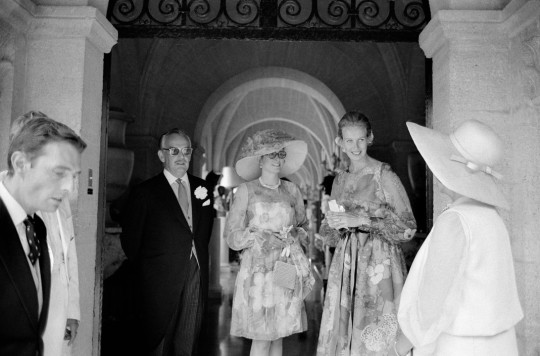
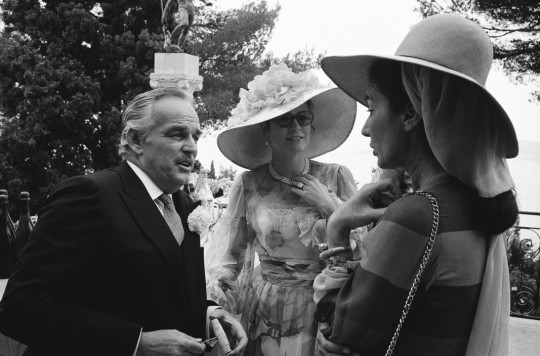
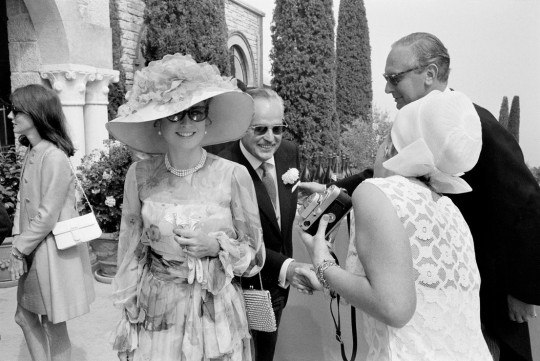
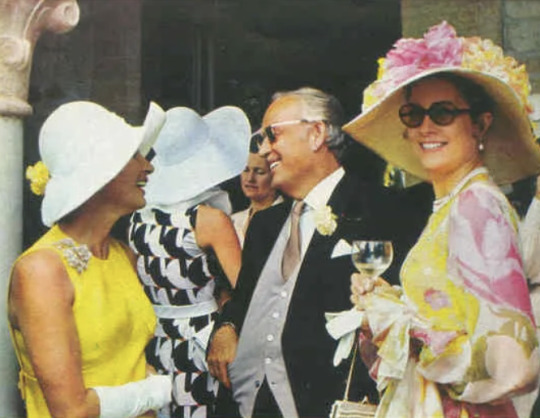
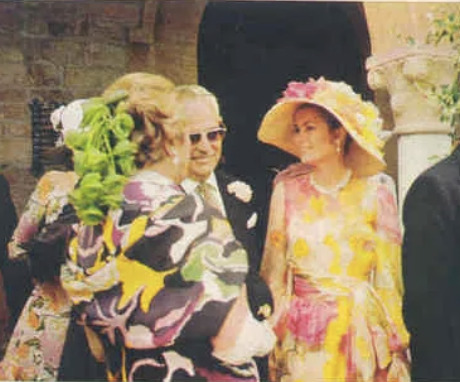
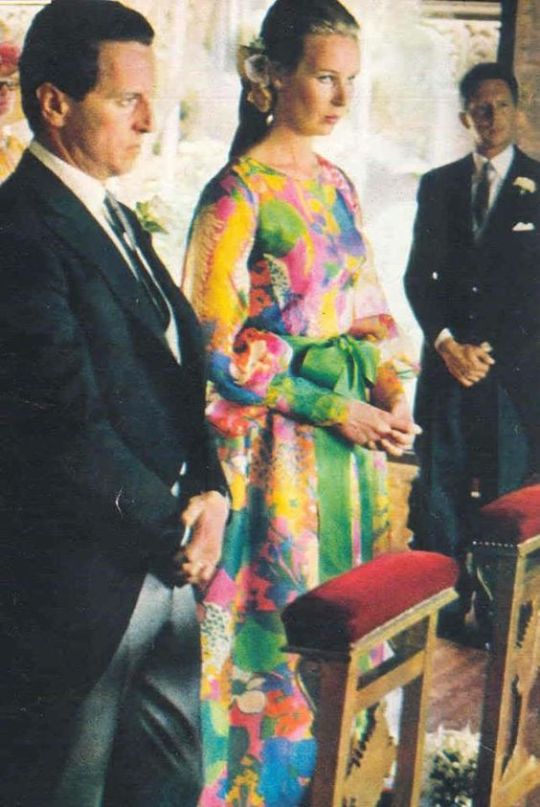

Princess Grace and Prince Rainier of Monaco at the wedding of Princess Maria Gabriella of Savoy and Robert de Balkany at Balsan Castle in Eze (France) on June 21, 1969.
#grace kelly#princess grace#royalty#maria gabriella of savoy#maria gabriela de saboya#robert de balkany#balkany#1969#royal wedding#1960s#yves saint laurent#grace de monaco#floral#pamela#eze
7 notes
·
View notes
Photo






María Luisa Gabriella of Savoy (1688 - 1714)
She was daughter of Victor Amadeus II, Duke of Savoy, and his wife Anne Marie d’Orléans, the youngest daughter of Philippe of France and Henrietta of England. Throughout her life, Maria Luisa remained close to her older sister Maria Adelaide who later married Louis, Duke of Burgundy, the eldest grandson of Louis XIV. In her youth, Maria Luisa was described as playful and fun loving and had received a good education. At the age of just thirteen, Maria Luisa married Philip V of Spain, to whom she was deeply devoted and who passionately loved her.The princesse des Ursins was a member of the household of the Queen. She would maintain great influence over Maria Luisa as her Camarera mayor de Palacio, chief of the household to the young queen, who was still a child.
A weak and ineffectual King, Maria Luisa held great influence over her husband. She is described as remarkably mature for her age, politically savvy, articulate and hardworking, and she has been credited with giving the normally passive Philip V the energy he needed to participate in warfare. In 1702, Philip V was obliged to leave Spain to fight in Naples as part of the ongoing War of Spanish Succession. During her husband’s absence, Maria Luisa acted as Regent from Madrid.

She was praised as an effective ruler, having successfully implemented various changes in government and insisted upon all complaints being investigated and reports made direct to her. Her leadership encouraged the reorganization in the junta and, in doing this, inspiring people and their cities to make donations towards the war effort. During her tenure as regent, she presided daily at the committee of government, gave audiences to ambassadors, worked for hours with ministers, corresponded with Philip, read war dispatches to her people from a balcony, and worked with preventing Savoy from joining the enemy. She offered her jewels for the defense of the Andalusian coast.The patriotism she displayed and the care she showed toward the people made her popularity soar and the population adored her.
After her husband's return, Maria Luisa resumed her role as queen consort. In 1704, the Princesse des Ursins was exiled at the order of Louis XIV, devastating Maria Luisa. However, in 1705, the Princesse returned to Madrid, much to the joy of the young queen. During the peace negotiations in 1711 and 1712, Maria Luisa stubbornly resisted any dismemberment of the Spanish Empire. The Queen gave birth to four sons, two of whom would survive infancy. Maria Luisa was mother of two Kings of Spain, Louis I and Ferdinand VI.
Weakened by childbirth, war, and tuberculosis, Maria Luisa failed despite the care of the best physician sent by Louis XIV from Paris. With a pious composure, she died on 14 February 1714 at the Royal Alcázar in Madrid, in her 25th year. Her husband, who had to be restrained from intercourse with her the day before she died, grieved deeply for her, but went hunting the day of her funeral. She was buried at San Lorenzo de El Escorial. In December, just months after Queen Maria Luisa’s death, her widower Philip V remarried, to Elisabeth Farnese, the only child and heiress of the Duke of Parma.
(x)(x)
#Maria Luisa Gabriella of Savoy#María Luisa Gabriela de Saboya#Queen of Spain#Spanish history#Women in History
62 notes
·
View notes
Photo

THE FAMILY
T.R.H. Prince Amedeo of Savoy-Aosta, Duke of Aosta; and Princess Maria Gabriella of Savoy
#the family#prince amedeo of savoy#duke of aosta#princess maria gabriella of savoy#italia#italy#savoy#saboya#savoia#italian royalty#italian royal family#roya#royal#royalty#royaltyedit
10 notes
·
View notes
Photo

Queen Maria Vittoria of Spain's Pearl Necklace Tiara
Find out more at Tiara Mania
#Queen Maria Vittoria#Spain#Italy#tiara#Spanish Royal Family#Italian Royal Family#Duchess of Aosta#pearl#Musy#convertible tiara#necklace#Princess Maria Gabriella#Savoy#tiaras#diadem#diadems#royal tiaras#jewels#royal jewels#royal#royaltyedit#royals#royalty#jewellery#jewelry#crown#crowns#crown jewels
328 notes
·
View notes
Link
0 notes